Castile (historical region)
Castile (/kæˈstiːl/; Spanish: Castilla [kasˈtiʎa]) is a historical region of Spain. Its extension is often ascribed to the sum of the regions of Old Castile and New Castile,[1] as they were formally defined in the 1833 territorial division of Spain. Those two regions cover the following modern autonomous communities: the eastern part of Castile and León, Castile-La Mancha, and Community of Madrid as well as Cantabria and La Rioja. However, it has been pointed out that in practice the modern limits of Castile are imprecise, and that this name has been used mainly as a reference for the image of Spain as a nation.[2]
Castile Castilla | |
|---|---|
 Two possible interpretations of the territory of Castile | |
| Country | Spain |
| Elevation | 800 m (2,600 ft) |
Castile's name is generally thought to derive from "land of castles" (castle in Spanish is castillo) in reference to the castles built in the area to consolidate the Christian Reconquest from the Moors.[1]
History
Originally an eastern county of the kingdom of León, in the 11th century Castile became an independent realm with its capital at Burgos. The County of Castile, which originally included most of Burgos and parts of Vizcaya, Álava, Cantabria and La Rioja,[3] became the leading force in the northern Christian states' 800-year Reconquista ("reconquest") of central and southern Spain from the Moorish rulers who had dominated most of the peninsula since the early 8th century.
The capture of Toledo in 1085 added New Castile to the crown's territories, and the battle of Las Navas de Tolosa (1212) heralded the Moors' loss of most of southern Spain. León was finally reunited with Castile in 1230, and the following decades saw the capture of Córdoba (1236), Murcia (1243) and Seville (1248). By the Treaty of Alcaçovas with Portugal on March 6, 1460, the ownership of the Canary Islands was transferred to Castile.
The dynastic union of Castile and Aragon in 1469, when Ferdinand II of Aragon wed Isabella I of Castile, would eventually lead to the formal creation of Spain as a single entity in 1516 when their grandson Charles V assumed both thrones. See List of Spanish monarchs and Kings of Spain family tree. The Muslim Kingdom of Granada (roughly encompassing the modern day provinces of Granada, Malaga and Almeria) was conquered in 1492, formally passing to the Crown of Castile in that year.
Geography
Since it lacks modern day official recognition, Castile no longer has clearly defined borders. Historically, the area consisted of the Kingdom of Castile. After the kingdom merged with its neighbours to become the Crown of Castile and later the Kingdom of Spain, when it united with the Crown of Aragon and the Kingdom of Navarre, the definition of what constituted Castile gradually began to change. Its historical capital was Burgos. In modern Spain, it is generally considered to comprise Castile and León and Castile–La Mancha, with Madrid as its centre. West Castile and León, Albacete, Cantabria and La Rioja are sometimes included in the definition (controversial for historical, political, and cultural reasons).
Since 1982 there have been two nominally Castilian autonomous communities in Spain, incorporating the toponym in their own official names: Castile and Leon and Castile-La Mancha. A third, the Community of Madrid is also regarded as part of Castile, by dint of its geographic enclosure within the entity and, above all, by the statements of its Statute of Autonomy, since its autonomic process originated in national interest and not in popular disaffection with Castile.[4]
Other territories in the former Crown of Castile are left out for different reasons. The territory of the Castilian Crown actually comprised all other autonomous communities within Spain with the exception of Aragon, Balearic Islands, Valencia and Catalonia, all belonging to the former Crown of Aragon, and Navarre, offshoot of the older Kingdom of the same name. Castile was divided between Old Castile in the north, so called because it was where the Kingdom of Castile was founded, and New Castile, called the Kingdom of Toledo in the Middle Ages. The Leonese region, part of the Crown of Castile from 1230, was from medieval times considered a region in its own right on a par with the two Castiles, and appeared on maps alongside Old Castile until the two joined as one region - Castile and Leon - in the 1980s. In 1833, Spain was further subdivided into administrative provinces.
Two non-administrative, nominally Castilian regions existed from 1833 to 1982: Old Castile, including Santander (autonomous community of Cantabria since 1981), Burgos, Logroño (autonomous community of La Rioja since 1982), Palencia, Valladolid, Soria, Segovia and Ávila, and New Castile consisting of Madrid (autonomous community of Madrid since 1983), Guadalajara, Cuenca, Toledo and Ciudad Real.
Language
The language of Castile emerged as the primary language of Spain—known to many of its speakers as castellano and in English sometimes as Castilian, but generally as Spanish. See Names given to the Spanish language. Historically, the Castilian Kingdom and people were considered to be the main architects of the Spanish State by a process of expansion to the South against the Moors and of marriages, wars, assimilation, and annexation of their smaller Eastern and Western neighbours. From the advent of the Bourbon Monarchy following the War of the Spanish Succession until the arrival of parliamentary democracy in 1977, the Castilian language was the only one with official status in the Spanish state.
Maps
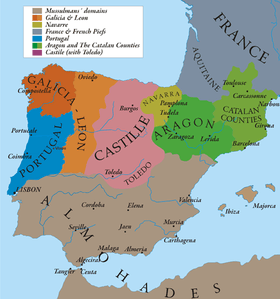 Castile in 1210
Castile in 1210 Kingdoms of the Crown of Castile in 1400. Note how Old Castile was called Kingdom of Castile and New Castile was called the Kingdom of Toledo.
Kingdoms of the Crown of Castile in 1400. Note how Old Castile was called Kingdom of Castile and New Castile was called the Kingdom of Toledo..jpg) Castile and other Iberian regions in 1770
Castile and other Iberian regions in 1770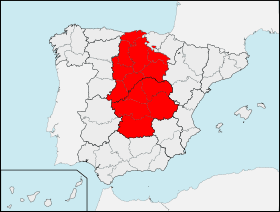 Old Castile and New Castile (1833 until the early 1980s).
Old Castile and New Castile (1833 until the early 1980s). Self-defined Castilian autonomous communities (since the 1980s). The Leonese region joined with Old Castile, Albacete region joined with New Castile, while Cantabria, La Rioja and Madrid became administrative regions of their own.
Self-defined Castilian autonomous communities (since the 1980s). The Leonese region joined with Old Castile, Albacete region joined with New Castile, while Cantabria, La Rioja and Madrid became administrative regions of their own.
Flags
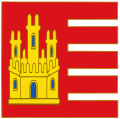 Older banner of the Kingdom of Castile.
Older banner of the Kingdom of Castile.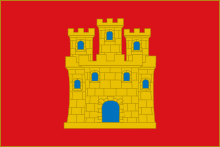 Historic Castilian flag. This flag is now used by Castilian regionalists.
Historic Castilian flag. This flag is now used by Castilian regionalists..svg.png) Historic flag of the Crown of Castile. This shows the union of the Kingdom of Castile with the Kingdom of Leon to form the Crown of Castile.
Historic flag of the Crown of Castile. This shows the union of the Kingdom of Castile with the Kingdom of Leon to form the Crown of Castile. Flag of the autonomous community of Castilla y León.
Flag of the autonomous community of Castilla y León.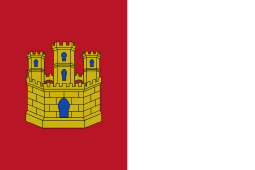 Flag of the autonomous community of Castile–La Mancha.
Flag of the autonomous community of Castile–La Mancha.
.svg.png) Flag used by Castilian Nationalists.
Flag used by Castilian Nationalists..svg.png) Flag used by Castilian Left followers.
Flag used by Castilian Left followers.
Coats of arms
.svg.png) Heraldic Sign of the Kingdom of Castile between 1171-1214
Heraldic Sign of the Kingdom of Castile between 1171-1214.svg.png) Historic coat of arms of the Kingdom of Castile between 1214-1230
Historic coat of arms of the Kingdom of Castile between 1214-1230 Coat of Arms of Castile with the Royal Crest
Coat of Arms of Castile with the Royal Crest.svg.png) Historic coat of arms of the Crown of Castile between 1230-1284.
Historic coat of arms of the Crown of Castile between 1230-1284.
This shows the union of the Kingdom of Castile with the Kingdom of Leon to form the Crown of Castile..svg.png) Historic coat of arms of the Crown of Castile between 1284-c.1400
Historic coat of arms of the Crown of Castile between 1284-c.1400.svg.png) Historic coat of arms of the Crown of Castile between c.1400-1500
Historic coat of arms of the Crown of Castile between c.1400-1500.svg.png) Historic coat of arms of the Crown of Castile between 1500-1705
Historic coat of arms of the Crown of Castile between 1500-1705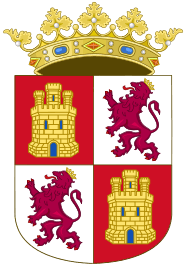 Coat of arms of the autonomous community of Castile and León
Coat of arms of the autonomous community of Castile and León Coat of arms of the autonomous community of Castile–La Mancha
Coat of arms of the autonomous community of Castile–La Mancha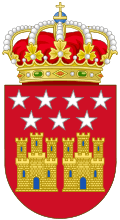 Coat of arms of the Community of Madrid. The two castles represent the two Castilian communities and Madrid as their union
Coat of arms of the Community of Madrid. The two castles represent the two Castilian communities and Madrid as their union
See also
- Castilian people
- Old Castile
- New Castile
- Crown of Castile
- Early history of the Kingdom of León
- Economic history of Spain
- Later history of Spain
- List of Castile Kings
- Castile soap
- Heraldry of Castile
- Music of Castile and Leon
- Castella, a food whose name originates from Castile.
- Two places in the United States have been named after this kingdom: Village of Castile and Town of Castile. Both are located in the state of New York.
References
- Lotha, Gloria (20 July 1998). "Castile (region, Spain)". Encyclopedia Britannica. Encyclopedia Britannica, Inc. Retrieved 5 November 2019.
- Moreno Hernández, Carlos (6 February 2009). En torno a Castilla [About Castile] (in Spanish). Lulu.com. p. 9. ISBN 9781409259923.
[...] el nombre de Castilla figura como primer título real, por lote de primogenitura, desde Fernando I a Fernando III, lo que origina que pase a designar, por sinécdoque -la parte por el todo- al reino que incluye primero León y luego Toledo y la baja Andalucía. Castilla será siempre, a partir de entonces, o bien el nombre que designa al más grande, rico y poblado de los reinos cristianos peninsulares –los otros son Portugal, Navarra y Aragón- o bien un territorio impreciso, sin fronteras fijas en los mapas, -o con fronteras distintas según el cartógrafo y la época- con una Castilla 'vieja' que puede incluir o no a León y una Castilla 'nueva' y 'novísima' que puede incluir o no unas u otras partes de La Mancha, de Murcia, de Extremadura o de Andalucía. En el siglo XIX, por medio de la extensión de la alfabetización y la enseñanza de la Historia de España en las escuelas, se difundirá una imagen de Castilla y de lo castellano al servicio del centralismo unificador ensayado desde el siglo XVIII por los Borbones que siguen reinando, el que conviene también ahora al nuevo sistema liberal moderado que sigue el modelo francés, aunque rebajado. [...] En paralelo, Castilla va a reinventarse desde las nuevas disciplinas de la Geografía, la Historia y la Lingüística de entonces como ese lugar central, identificado ahora con la meseta o mesetas, que es preciso regenerar, el gran desierto empobrecido sin árboles ni agua alrededor de Madrid, centro y cima de un espacio elevado desde el que se ejerce el poder como núcleo que ha sido y es de la cultura y la lengua española.
- Martínez Díez, Gonzalo (2005). El Condado de Castilla, (711-1038) - La Historia frente a la Leyenda. Marcial Pons, Ediciones de Historia. p. 819. ISBN 84-9718-275-8.
- "En efecto, la negativa de las provincias castellano-manchegas a la integración de Madrid en su región, su falta de entidad regional histórica, su existencia como Área Metropolitana y, el ser la Villa de Madrid la capital del Estado significaron que la provincia madrileña partiese de cero en el camino de su autonomía, sin trámites intermedios, sin régimen preautonómico". "La falta de entidad regional histórica de Madrid, hizo preciso acudir a la vía del artículo 144, apartado a) de la Norma Fundamental: "Las Cortes Generales, mediante ley orgánica, podrán por motivos de interés nacional: a)Autorizar la constitución de una Comunidad Autónoma cuando su ámbito territorial no supere el de una provincia y no reúna las condiciones del apartado 1 del artículo 143." Blanca Cid. Directora de Gestión Parlamentaria de la Asamblea de la Comunidad de Madrid. (2003). "Sinopsis del Estatuto de la Comunidad de Madrid" (in Spanish). Archived from the original on 2009-12-11. Retrieved 2009-12-26.
- El escudo y la bandera. Memoria y diseños de los símbolos de la Comunidad Autónoma de Madrid., page 5. Santiago Amón, published by Comunidad de Madrid. ISBN 84-500-9765-7